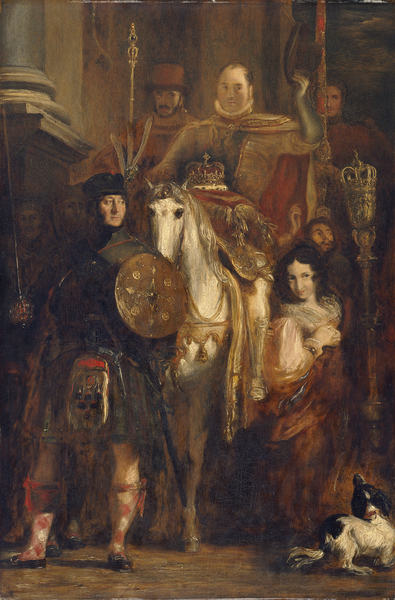Portrait of Sir Alexander Keith
Sir David Wilkie R.A. 18/11/1785 - 1/6/1841
Summary
Full length portrait of Sir Alexander Keith. The subject is seated on a grey horse with golden saddlery; he sits before a crown, rested on a red cushion with gold embroidery and lifts his hat in salute. Flanking the figure of Alexander and set back in the shadows are the Knight Marischal's esquires; the Lord Francis Leveson-Gower is mounted to his left, bearing the Sceptre and to his right, George Douglas bears the Sword of State. In the left foreground George Campbell stands at the foot of a column, wearing highland dress and carrying a sword and shield. To the right of Alexander a young woman stands looking towards the viewer with her hands clasped to her chest, and a dog laid at her feet. Standing between the figure of the young woman and George Douglas is the figure of a man, arms raised staring wide-eyed at the golden mace of the Court of the Exchequer, which is stood against a wall to the far left. All but the figure of the woman have their eyes fixed to the right. The background is dark with indications of an architectural context.
Display Label
A Highland Romance: Victorian Views of Scottishness The popular idea of Scottishness in the 1800s came from Sir Walter Scott (1771–1832), who fictionalised exciting episodes from Scottish history. He created a colourful Highland identity for his nation, based on the customs and landscape of the sparsely populated mountainous areas. For Lowland Scots – the majority of the population – it was a fiction they took up gladly, perhaps because it emphasised difference from the English. However, most Victorians, Scots and English, felt cultural difference to be perfectly compatible with political union. Queen Victoria’s regular visits to Scotland encouraged the English to view it as a simple country retreat. By the end of her reign her wealthier English subjects came to regard Scotland principally as an arena for shooting, fishing and golf. Artists from both sides of the border visualised the stags, castles, mountains and tartan that made up this Victorian myth. Their paintings reaffirmed impressions gleaned from Scott’s novels and from tourist guide books to Scotland. The fact that Scotland was an industrialised nation taking an active part in the British Empire was largely ignored. Popular art and literature fed the ‘tartan monster’, refining a checklist of clichés that even today remain key to the marketing of Scotland. A number of local industrialist patrons who bought paintings with Scottish subjects later gave them to Manchester Art Gallery. As a result the Gallery has a particularly good late Victorian collection. Here is ‘Scottishness’, as seen from Manchester in the late 1800s.
Object Name
Portrait of Sir Alexander Keith
Creators Name
Date Created
1830
Dimensions
Canvas: 71.8cm x 48.3cm
Framed: 85cm x 61.6cm
accession number
1972.53
Place of creation
United Kingdom
Support
panel
Medium
oil paint
Credit
Purchased with the assistance of Victoria & Albert Museum Purchase Grant Fund
Legal
© Manchester Art Gallery

